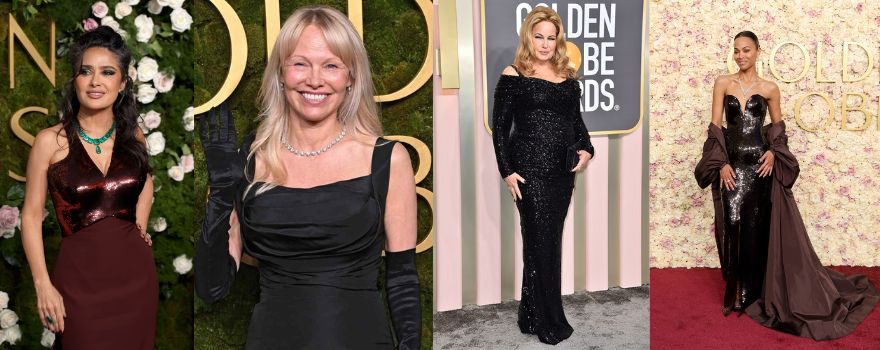Midlife Women Were the New Prime at the Golden Globes 2025
07 JAN 2025
From Demi Moore's first win at 62 to Fernanda Torres, 59, triumphing over strong contenders in her category the awards celebrated women whom Hollywood once considered 'past their prime.'

Demi Moore (62), Fernanda Torres (59), Jodie Foster (62), Nicole Kidman (57) (From left to right)
For years, Hollywood has been a place where women over 50 were relegated to the sidelines, dismissed as “past their prime.” Leading roles became scarce, opportunities dwindled, and the industry's relentless pursuit of youth made midlife feel like a death sentence for many careers. But something extraordinary happened at this year’s Golden Globes—a celebration of women who have defied these outdated notions and emerged more powerful than ever.
This year, the Golden Globes weren’t just about dazzling outfits and touching speeches. They highlighted a shift in perspective, showing that midlife isn’t the end but a bold new beginning. Seven women over 40 won Best Actress awards, and the red carpet was graced by stars radiating confidence, elegance, and unfiltered authenticity. This year, seven of the best actress gongs went to women over the age of 40, including Fernanda Torres (59) for I’m Still Here, Jodie Foster (62) for True Detective: Night Country and Zoe Saldaña (46) for Eva Pérez.
Take Demi Moore, for example. At 62, she earned her first Golden Globe for her role in The Substance, a powerful body horror film that challenges Hollywood’s ingrained ageism and sexism. Her win wasn’t just a personal triumph but a significant cultural milestone. For years, Moore was labeled a "popcorn actress," known for box office hits but often overlooked for her talent. However, her commanding performance in The Substance couldn’t be ignored, and the industry finally gave her the recognition she deserved. During her acceptance speech, Moore emotionally recounted being told she wasn’t “enough”—not smart enough, attractive enough, or worthy enough.
The night wasn’t solely about Moore. Fernanda Torres, at 59, captivated audiences with her layered performance in I’m Still Here, while Jodie Foster, 62, reaffirmed her status as a Hollywood legend with her role in True Detective: Night Country. Even Zoe Saldaña, at 46, shone brightly, earning acclaim for her portrayal of Eva Pérez. Together, these victories delivered a strong statement: the so-called “quiet years” for actresses are a thing of the past.
Hollywood’s history of sidelining women in midlife is no secret. For years, actresses between 40 and 60 seemed to vanish from screens. They’d reappear later, playing grandmothers or elder stateswomen, while their male counterparts continued to land leading roles well into their 60s and beyond. As host Nikki Glasser quipped during the ceremony, “If you’re a woman over 50 in a lead role, they call it a comeback. If you’re a guy over 50 in a lead role, congratulations—you’re about to play Sydney Sweeney’s boyfriend.”


Salma Hayek (58), Pamela Anderson (57), Jennifer Coolidge (63), Zoe Saldana (46) (From left to right)
But this year’s This year’s Golden Globes were about changing how Hollywood views aging. Women like Nicole Kidman (57) turned heads, not just for their acting but for the boldness of their choices. Kidman’s role in Babygirl, a film that flips Hollywood’s obsession with age-gap romances on its head, was both daring and necessary. And let’s not forget Pamela Anderson, who arrived makeup-free, styling herself without a glam team, and proving that authenticity is the new luxury.
Anderson, at 57, exemplifies the strength that comes with embracing your story. After years of being shaped by others’ perceptions, she has experienced a revival as an author, producer, and the focus of a hit Netflix documentary. Similarly, Jennifer Coolidge remains a favorite among audiences. At 63, Coolidge’s unique mix of humor and vulnerability has solidified her place as one of the most cherished actresses of her generation.
What makes this shift so exciting isn’t just that these women are still working—it’s that they’re doing some of their best work yet. Much of this resurgence can be credited to the rise of streaming platforms, which have created space for more diverse stories, including those centered on midlife women. Actresses like Reese Witherspoon (48) and Jennifer Aniston (55) have taken matters into their own hands, producing shows like The Morning Show that offer rich, complex roles for women in their 40s and beyond.
But it’s not just about looking younger or relying on cosmetic procedures to stay relevant. Women like Pamela Anderson are proving that authenticity is just as compelling as youth. Hollywood’s obsession with Botox and fillers might have eased some of the industry’s ageism, but it’s not the whole story. The real revolution lies in the stories being told that resonate with a generation of viewers who want authenticity over airbrushing.
For millennials, now entering middle age themselves, this shift is particularly poignant. They’re watching women their age—or older—shine in ways that were once deemed impossible. And as the largest consumer group of TV and film content, they’re shaping the demand for these narratives.
Hollywood still has a long way to go in achieving true equality, but if the 2025 Golden Globes are any indication, the industry is finally learning that age is just a number—and that women in midlife have stories worth telling, awards worth winning, and a presence that can’t be ignored.
As Demi Moore said in her speech, “This isn’t the end; this is the beginning.”

1734164122.jpg)



















